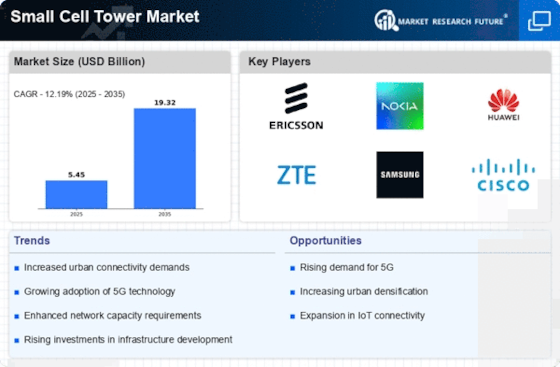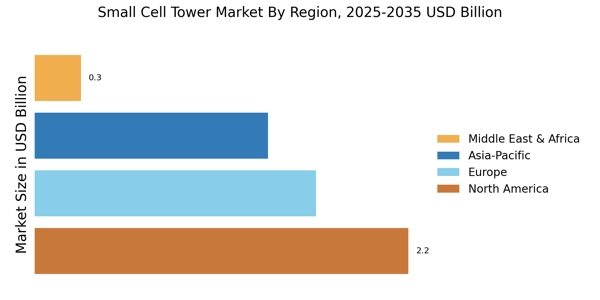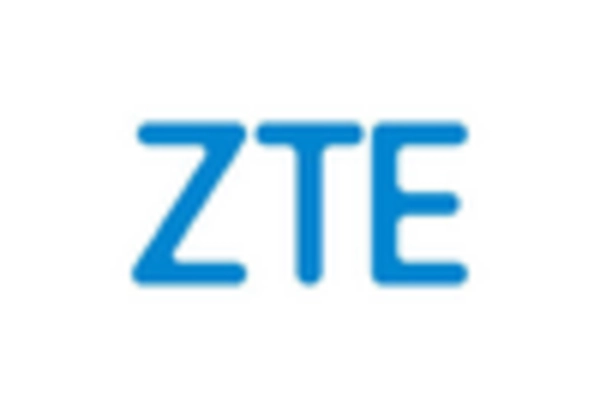Regulatory Support and Policy Frameworks
The Small Cell Tower Market benefits from favorable regulatory support and policy frameworks that facilitate the deployment of small cell infrastructure. Governments are increasingly recognizing the importance of enhancing telecommunications networks to support economic growth and innovation. Policies that streamline the permitting process for small cell installations are being implemented, which could potentially accelerate deployment timelines. For instance, some regions have established guidelines that reduce the time and cost associated with obtaining permits for small cell towers. This regulatory environment is likely to encourage investment in the Small Cell Tower Market, as companies seek to capitalize on the opportunities presented by supportive legislation.
Rising Demand for Enhanced Mobile Services
The Small Cell Tower Market is driven by the rising demand for enhanced mobile services among consumers and businesses alike. As mobile applications and services become increasingly integral to daily life, users expect reliable and high-speed connectivity. The proliferation of smart devices and the Internet of Things (IoT) further amplify this demand, as these technologies require robust network support. Market data indicates that the number of connected devices is expected to reach over 30 billion by 2025, which underscores the necessity for small cell towers to provide the required network capacity and coverage. Consequently, the Small Cell Tower Market is likely to experience growth as service providers strive to meet the evolving expectations of their customers.
Urbanization and Increased Connectivity Demand
The Small Cell Tower Market is experiencing a surge in demand due to rapid urbanization. As cities expand, the need for enhanced connectivity becomes paramount. Urban areas are densely populated, leading to increased data consumption and the necessity for robust network infrastructure. According to recent data, urban centers are projected to account for over 70% of the world's population by 2050, which suggests a corresponding rise in the demand for small cell towers. These towers facilitate improved coverage and capacity, addressing the challenges posed by high user density. Consequently, the Small Cell Tower Market is likely to see significant growth as urban planners and telecommunications companies prioritize the deployment of small cell solutions to meet the connectivity needs of urban dwellers.
Technological Advancements in Telecommunications
The Small Cell Tower Market is significantly influenced by ongoing technological advancements in telecommunications. Innovations such as 5G technology are driving the deployment of small cell towers, which are essential for delivering high-speed internet and low-latency services. The transition to 5G is expected to create a substantial increase in data traffic, with estimates suggesting a tenfold increase in mobile data traffic by 2025. This necessitates the installation of small cell towers to ensure seamless connectivity and support the growing number of connected devices. As telecommunications companies invest in upgrading their infrastructure, the Small Cell Tower Market is poised for expansion, driven by the need to accommodate advanced technologies and enhance user experiences.
Increased Investment in Telecommunications Infrastructure
The Small Cell Tower Market is witnessing increased investment in telecommunications infrastructure, driven by both private and public sector initiatives. As the demand for high-speed internet and mobile connectivity escalates, telecommunications companies are allocating substantial resources to expand their network capabilities. Recent reports indicate that global investments in telecommunications infrastructure are projected to exceed 1 trillion dollars by 2025. This influx of capital is likely to facilitate the deployment of small cell towers, which are essential for enhancing network performance and coverage. As a result, the Small Cell Tower Market stands to benefit from this trend, as companies seek to modernize their infrastructure to meet the growing connectivity demands of consumers and businesses.


















Leave a Comment